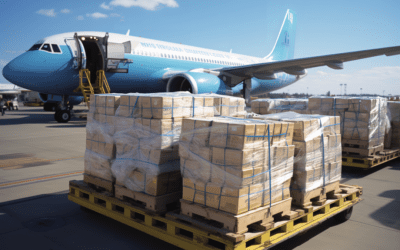In 2022, President Joe Biden signed the Inflation Reduction Act of 2022 (IRA) into U.S. law, creating immediate and long-term impacts on the domestic supply chain. The law was enacted in direct response to rising inflation and as a defense against any looming recessions. The act includes more than $300 billion in renewable energy research and funding for climate change initiatives. It also includes incentives for businesses that embrace clean energy programs.
The act aims to reduce the nation’s emissions by 50% over the next 7 years and create over a million new jobs. It’s one of the largest and most comprehensive efforts in U.S. history to battle climate change.
To accomplish this, the act will revamp the manufacturing, supplying, and transportation of goods across the nation. This will affect the domestic supply chain in the following three ways:
Article Overview
More electric vehicles (EVs)
The Inflation Reduction Act contains tax credits of up to 30% of the total price of any electric vehicle. The cap is $40,000 per EV. California is also expected to approve a bill that bans the sale of gas-powered cars by 2035. These two factors will demand the immediate growth of electric-powered vehicles in LTL fleets. They may also foreshadow the potential introduction of more electric vehicles in FTL fleets.
Fuel costs have greatly impacted freight carriers for many years, and 2022 was no exception. In this especially volatile diesel market, carriers must embrace the opportunity to break free from the global fuel economy. This will help them maximize their efficiency moving forward. However, transitioning to an electric fleet will take time. Most projections agree that electric trucks will not see their grand debut for at least another 8-10 years. LTL freight could see an increase sooner, as they would rely on more readily available and smaller EVs.
The advantages of using EVs for freight transport include reduced emissions and less noise, but EVs do come with their challenges. Also, long-distance travel is still one of the major concerns among manufacturers. Drivers would need a steady supply of charging stations nationwide, which are few and far between compared to diesel pumps. Even with enough charging stations, it would take several hours to fully charge an EV of that size and weight. This would cost everyone involved valuable time.
As it becomes more evident that EVs are the future of transportation in the country, truck manufacturers must address these issues if carriers are expected to bolster their fleets with more electric trucks.
Increased demand for renewable energy components
The Inflation Reduction Act aims to reduce the cost of clean energy resources, like wind turbines, batteries, and solar panels. Renewable energy sources have become more affordable over the past decade. Solar panel costs dropped more than 85%, and wind turbine expenses have fallen 65% since 2010. Not only will this reduce the annual cost of energy for warehouses and distribution centers, but it’s also expected to increase the demand for renewable energy components.
This should result in more renewable energy manufacturers and a wider array of consumers. Another result — an abundance of components and machinery that will rely on trucks for transportation to their destinations.
The demand for these components will begin domestically. The act requires U.S.-based EV manufacturers to begin sourcing at least 40% of their battery parts in the U.S. or allied countries by 2024. This increases to 100% by the end of the decade.
Currently, China boasts the lion’s share of EV battery production, so the transition to U.S.-based companies will take time. However, requiring domestic production is expected to lead to a drastic increase in factory jobs within the country.

More sustainable ports
The Inflation Reduction Act is granting over $3 billion to curb air pollution caused by the country’s ports. $2.6 billion of that will be allocated to the National Oceanic and Atmospheric Administration (NOAA) to protect marine habitats and shore up port communities’ defenses against natural disasters.
The remaining funds will be used to provide zero-emission equipment for ports to handle their cargo. This only includes human-operated machinery, which means that automated equipment is not eligible for the grant.
The grant is still expected to contribute greatly to the ports’ efforts in reducing its emissions. Over the next decade, U.S. ports are expected to commit nearly $50 billion toward renewable resources and infrastructure.
Los Angeles and Long Beach ports are actively testing hundreds of zero-emission equipment at their locations. Other ports are expected to join them in the coming years. Examples of this cleaner equipment include electric tugboats and the implementation of more EVs for drayage.
These changes are not only expected to reduce ports’ carbon footprints but also drastically improve the air quality surrounding those areas. For the 39 million people in the U.S. who live within 3 miles of a port, this is certainly a step in the right direction.
Domestic Supply Chain Impacts
The Inflation Reduction Act will have a major impact on the country’s domestic supply chain, affecting nearly every level of the delicate system. It places more focus on the production of EVs, which will slowly take over the gas-powered vehicles of today.
LTL freight will be the first to adopt some of these changes, but FTL carriers should begin exploring options so they’re not left behind. Warehouses and distribution centers should also get ahead of the curve, as the act makes it more affordable to operate with zero-emission equipment.
Ports are already testing ways that renewable resources can be used in their day-to-day operations, with even more changes and improvements on the way. As the country strives to reduce its carbon footprint, the supply chain must adapt and look forward to new technologies ahead of time to keep up.






